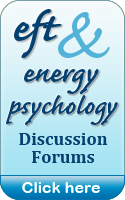Self-Healing: Brief psychotherapy with WHEE
the Wholistic Hybrid derived from EMDR and EFT and other approaches
By
Daniel J Benor, MD, Psychiatrists, Amer. Board Integrative Holistic Med
(Add or view comments at the bottom of the page.)
Clinical Explorations
When I learned about psychotherapy as a teenager, I knew that was what I wanted to do. I couldn't imagine anyone actually getting paid to do something so fascinating. I studied psychology as my undergraduate pre-med major, endured the challenges of medical school, with a year's break for an NIMH research fellowship in psychiatry and for regrouping my battered energies. I trained as a psychiatrist 1967-1973, (with two intervening years in the Air Force during the Vietnam War), when psychiatry was mostly psychotherapy. Over the years, managed care has squeezed psychiatrist towards medication management. While I've resisted prescribing medications exclusively, it is pretty difficult to do much psychotherapy in a 15-20 minute medication visit--the amount of time allowed under managed care.
Fortunately, I worked mostly with children (in a clinic and a day hospital), and was allowed the "luxury" of 30-minute sessions because I had to speak with parents, teachers, school counselors, and pediatricians, in addition to pharmacists and managed care companies -- all in addition to speaking with the children.
I constantly sought to develop ways of providing psychotherapy along with the medications, but was unable within my limited timeframe to use the psychodynamic approaches I was taught as a psychiatric resident. Eye Movement Desensitization and Reprocessing (EMDR - see: www.emdr.com) was a blessing to me, as well as to my clients. I was able to use EMDR with children who had post-traumatic stress disorders, as children respond very quickly to this approach -- not having barnacles on their problems like adults do. I also used EMDR to de-stress myself.
It is recommended that EMDR should be done only during sessions with the therapist. This is to prevent being overwhelmed by intense emotional releases that can occur during treatment. This left me uneasy about sending children home to use EMDR on their own.
I then learned to use the Emotional Freedom Technique (EFT) of Gary Craig (www.emofree.com) and other Energy Psychology approaches. In EFT and related therapies you tap or press a finger at a series of acupuncture points on your face, chest and hand, while reciting an affirmation. Because it works more rapidly than EMDR and does not evoke intense emotional releases, it can be used as self-healing. (Affirmations are described below, under the WHEE technique.)
This works more quickly than EMDR and has extra advantages. Because it works rapidly and does not evoke intense emotional releases, I started offering "two (or three) for the price of one" introductions to EFT to children together with their mothers, including their fathers as well when they are present. This way, the children more often accept the therapy and comply with the recommendation to use it at home to deal with stresses. Parents are more confident of its therapeutic efficacy because they have experienced its benefits themselves, and therefore encourage their children to use it more often.
I had difficulty introducing EFT in my work settings. EMDR has an extensive research base to confirm its efficacy in treating post-traumatic stress disorders (PTSDs). On the basis of my certification in EMDR, I was able to obtain official permission (from the administrators of the child and adolescent clinic where I work) to use this with their clients. Because EFT has no research base, they would not grant me permission to use it. Giving this a hard think, I turned it around and now call it an "affirmation technique." No one has faulted me for using affirmations in therapy, and never mind what clients do with their hands on their own bodies while they recite these.
In an introductory workshop by Asha Nahoma Clinton on Seemorg Matrix Therapy, Asha observed that alternating tapping the eyebrow points while reciting the affirmation works just as well as the entire series of EFT points. Ever conscious of my time limitations, I immediately started exploring this hybrid approach, which combines aspects of EMDR and EFT (that I now call the Wholistic Hybrid derived from EMDR and EFT, or WHEE).
EMDR suggests the use of a "butterfly hug" as one of its self-treatment interventions, particularly for children: Your arms are crossed so that your hands rest on your biceps muscles, and you alternate tapping on each arm with your hands. Instead of tapping at the eyebrows, I often have children and parents use the butterfly hug with the affirmation. Many find the self-hug comforting, in addition to being highly effective in combination with the affirmation.
WHEE has been hugely successful for several reasons.
- It takes a fraction of the time that EFT and other MBTs require.
- It allows for much greater flexibility in working on target problems within the session because it is so rapid. If the child is successful but the parent is not, or vice versa, there is plenty of time to explore alternative target symptoms or alternative methods of addressing these.
- It is better accepted and the compliance outside the therapy room is much higher because of this simplicity.
- It works marvelously well and rapidly on pains, often releasing them substantially or entirely within minutes, including tension headaches, migraines, backaches, arthritis, pain following surgery and injuries, cancers, fibromyalgia and more.
- It is excellent for allergies, though it may take several days to be effective for the latter.
- It is tremendously empowering, as it is so simple and so rapidly effective in self-healing.
Affirmation
Here is a generic affirmation adapted from EFT: "Even though I have this [anxiety, panic, fear, etc. [be specific when filling in the blank], I wholly and completely love and accept myself. For those comfortable with a spiritual connection, another strong affirmation is, "I know that [God/ the Infinite Source/ Allah/ Christ/ insert your personal preference] loves and accepts me unconditionally."
Prior to doing this self-healing technique, it is helpful to assess how strong the negative feeling is that you want to address. The most commonly used is the Subjective Units of Distress Scale (SUDS), where you rate your feeling on a scale from 0 (not bothering you at all) to 10 (the worst it could possibly feel).
After tapping for a few minutes, check the SUDS again. It will usually go down. Repeat the assessing and tapping until it is zero. Then you can build up a positive affirmation to replace the negative, simply stating the positive as you tap.
If the numbers do not shift after you have tapped, you can give yourself a gentle massage on the releasing spot, located just below the collar bone at its midpoint. No affirmation is needed here. Then return to tapping.
Teenagers would often refuse to use either of these tapping approaches outside of the therapy room. Their typical comment was, "Sure, dad! Like I'm going to tap my forehead or pat my arms in front of my friends! They'll think I'm some sort of nut case!" I speculated to myself that if they alternated tapping with their tongue on their teeth on the left and then on the teeth on the right this should work just as well, and found that indeed it does. This has been received much better by those who are shy or uncomfortable with tapping in public.
A deep breath (drawn from John Diepold's Touch and Breathe approach) following the affirmation facilitates releases.
Holding your other hand over your heart center (chakra) while you tap or touch your eyebrow points deepens the effects.
Blocks to releasing negativity are effectively managed by massaging the sore-spot/ releasing point below the midpoint of the collar bone.
Clinical example (assumed name, composite case):
Six-year old "Joe" had been seriously abused emotionally, physically and sexually by his mother from at least the age of two and probably earlier. He was removed from her home at age four, and had nine foster home placements before his latest foster mother suggested to the welfare worker that counseling might be helpful to him for his temper outbursts, fighting children in his first grade class and after school, inability to fall asleep till past midnight, frequent nightmares and night terrors, and bedwetting -- his more serious problems. In addition, he was unable to sit still, was impulsive, distractible, constantly forgetting and losing things, and had no friends.
I diagnosed PTSD (moderately severe) and possible attention deficit hyperactivity disorder (ADHD). I prescribed small doses of Ritalin, as this acts within minutes and, if effective, could provide rapid relief for some of his problems. He responded well to the medication and was much better able to sit and attend in class, less impulsive, and less forgetful. His other symptoms remained. He also had counseling sessions weekly with a social worker at the clinic where I work, focused on issues of relating to his new family, multiple losses, and PTSD issues.
At the initial interview, I taught Joe and his mother to use the butterfly hug. Joe chose an affirmation about one of the bad memories he had of being left in the dark cellar by his mother. He was unable to count, so I had him show me a Visual Analog Scale ("VAS" -- equivalent of a SUDS) with the gap between his hands representing how big his bad feeling was when he thought about being in the dark cellar. He opened his arms wide and said, "I can't reach to show you how big the bad feeling is." Within minutes of using the butterfly hug, his hands were touching in the VAS. He had reduced the bad feelings to zero.
Over the next several weeks, Joe (with the help of his mother) used the butterfly hug daily on various fears, difficulty falling asleep, and nightmares, as well as to calm down after he had temper outbursts.
Within two months, Joe was functioning at near-normal levels of behavior in school and at home. Counseling continued for another four months and was discontinued. I have followed him for Ritalin prescriptions for two years and we have all been pleased with his excellent academic progress in school, and with his good behavioral and improved social adjustments in school and at home.
I have also had excellent results with proxy use of WHEE. In proxy treatments, the person receiving the treatment focuses her or his awareness on another person who is intended to receive the treatment. Therapists may do this on themselves as proxies for their clients. (While this may seem far-fetched, it has an excellent basis in research as distant healing (Benor 2001).
Clinical example: I visited a healer who was baby-sitting a six-year old boy who has developmental delays and may have mild autism. He was severely frightened by the healer's two dogs, who were lively and playful, and nearly as frightened of her two cats. He had been in the healer's home several times previously, and was constantly on the alert, if not alarmed, by any approach of the animals to within several feet. Within minutes of surrogate tapping for his fears of the animals, he was markedly less fearful, and within a few more minutes he was even able to pet the quieter dog. He had never been that calm before in the animals' presence, and certainly would not have petted them.
Clinical efficacy
I find that 85-90 percent of clients obtain immediate benefits from WHEE. When they practice this for their problems at home, there is almost universal success. In over five years of offering a money back guarantee, I've had only one person claim it (on a telephone session).
WHEE is rapidly and potently effective for physical and emotional pains, post-traumatic stress, unresolved emotional problems (e.g. prolonged bereavement, festering angers, emotional/relational hurts, anxieties, phobias, insecurities, lack of self-confidence), sports problems in relationships, and performance enhancement.
WHEE is empowering. It gives you a clear way to deal with almost any problem you might encounter that raises negative feelings. It helps to clear the "bucket" of emotinal dross - that place inside where we stuff unresolved feelings when we don't know how to resolve a stressful situation.
WHEE helps to forgive others for their transgressions, heps you to forgive yourself for not having done better than your best at the time when you stuffed feelings into your inner "bucket," and to accept that you did the best you could at the time and now are more competent to deal with the residues of the situation that left you with bad feelings.
Where it doesn't work, the most frequent problem are:
1. The client has not targeted the problem accurately in the affirmation.
2. They are reporting that the memory has not faded. This is an incorrect expectation, as it is the negative feelings about the memory that fade, not the factual memory.
3. They have forgotten to massage the releasing point when there is a block in the process.
Many of my clients are children. I invite parents to use WHEE to explore and practice releasing old hurts and fears together with their children. I believe that when families work together there can be exponential changes for each individual in the family.
I have had enthusiastic feedback on successes from therapists who learned WHEE through lectures and workshops that I teach internationally.
Theoretical considerations and conclusions
I see a progression in Energy Psychology (often called meridian based therapies - MBTs) towards greater and greater simplicity. Gary Craig, with EFT, has simplified the procedures of Thought Field Therapy (TFT). WHEE provides a further abbreviated tapping procedure with affirmations.
There has been controversy and extensive discussion in Energy Psychology circles on whether the specific protocols of TFT are necessary, or whether the generic EFT protocol is adequate, with strongly held opinions on both sides. We can anticipate further discussion on the benefits and limitations of WHEE and related approaches.
EMDR has a solid basis in research, demonstrating its efficacy in treating stress related disorders (www.emdr.org). Energy Psychology is still in early stages of research. WHEE, drawing from EMDR (though clearly not following the standard EMDR protocols), can claim to have a research base to support its efficacy.
PRACTICAL CONSIDERATIONS
Energy Psychology has only modest research to support its efficacy. EMDR has considerable, impressive research showing it is effective in helping adults and children deal with PTSD. By using WHEE the MBTs tap into the EMDR research database. (See selected samples below).
Status of EMDR acceptance for PTSD
American Psychiatric Association. Practice Guideline for the Treatment of Patients with Acute Stress Disorder and Posttraumatic Stress Disorder. Arlington, VA: American Psychiatric Association Practice Guidelines 2004.
EMDR has been given the same status as Cognitive Behavioral Therapy (CBT) as an effective treatment of ameliorating symptoms of both acute and chronic PTSD.
EMDR Research
Acierno, R., Hersen, M., Van Hasselt, V. B., Tremont, G., & Meuser, K. T., . Review of the validation and dissemination of eye-movement desensitization and reprocessing: A scientific and ethical dilemma. Clinical Psychology Review 1994, 14, 287-299. ( "Cautionary" article about EMDR)
Carlson, J. G., Chemtob, C. M., Rusnak, K., Hedlund, N. L., & Muraoka, M. Y. Eye movement desensitization and reprocessing for combat-related post-traumatic stress disorder. Journal of Traumatic Stress (in press 1997). .
Chemtob, C. & Nakashima, J. Eye movement desensitization and rereprocessing (EMDR) treatment for children with treatment resistant disaster related distress. Presented at the annual meeting of the International Society for Traumatic Stress Studies, San Francisco (1996, November).
Edmond, T. & Rubin, A. Evaluating the effectiveness of EMDR in reducing trauma symptoms in adult survivors of childhood sexual abuse. Presented at the annual conference of the EMDR International Association, Denver (1996, June).
Goldstein, A. & Feske, U. Eye movement desensitization and reprocessing for panic disorder: A case series. Journal of Anxiety Disorders 1994, 8, 351-362.
Grainger, R. D., Levin, C., Allen-Byrd, L., Doctor, R. M., & Lee, H.An empirical evaluation of eye movement desensitization and reprocessing (EMDR) with survivors of a natural catastrophe. Journal of traumatic Stress (in press 1997). .
Greenwald, R. Using EMDR with children. Available from EMDR, P.O. Box 51010, Pacific Grove, CA 93950-6010 with formal training 1993.
Greenwald, R. The information gap in the EMDR controversy. Professional Psychology: Research and Practice 1996, 27, 67-72.
Lipke, H. J. Survey of practitioners trained in eye movement desensitization and reprocessing. Paper presented at the annual convention of the American Psychological Association, Los Angeles, CA 1994, August.
Marcus, S., Marquis, P., & Sakai, C. Eye movement desensitization and reprocessing: A clinical outcome study for post-traumatic stress disorder. Paper presented at the American Psychological Association annual convention, Toronto 1996, August.
Paulsen, S. Eye movement desensitization and reprocessing: Its cautious use in the dissociative disorders. Dissociation 1995, 8, 32-44.
Sanderson, A. & Carpenter, R. (1992). Eye movement desensitization versus image confrontation: A single-session crossover study of 58 phobic subjects. Journal of Behavior Therapy and Experimental Psychiatry, 23, 269-275.
Scheck, M. M., Schaeffer, J. A., & Gilette, C. S. (in press). Brief psychological intervention with traumatized young women: The efficacy of eye movement desensitization and reprocessing. Journal of Traumatic Stress.
Shapiro, F. Efficacy of the eye movement desensitization procedure in the treatment of traumatic memories. Journal of Traumatic Stress 1989a, 2, 199-223.
Shapiro, F. Eye movement desensitization: A new treatment for post-traumatic stress disorder. Journal of Behavior Therapy and Experimental Psychiatry 1989b, 20, 211-217.
Shapiro, F. Eye movement desensitization and reprocessing procedure: From EMD to EMD/R - A new treatment model for anxiety and related traumata. The Behavior Therapist 1991a, 14, 133-135.
Shapiro, F. Eye movement desensitization and reprocessing: A cautionary note. The Behavior Therapist 1991b, 14, 188.
Shapiro, F. Eye movement desensitization and reprocessing (EMDR) in 1992. Journal of Traumatic Stress 1993a, 6, 417-421.
Shapiro, F. Eye movement desensitization and reprocessing: A new treatment for anxiety and related trauma. In Lee Hyer (ed.) Trauma victim: Theoretical and practical suggestions. Muncie, IN: Accelerated Development 1994.
Shapiro, F. Eye movement desensitization and reprocessing: Basic principles, protocols and procedures. New York: Guilford Press 1995.
Shapiro, F. Eye movement desensitization and reprocessing (EMDR): Evaluation of controlled PTSD research. Journal of Behavior Therapy and Experimental Psychiatry 1996, 27, 209-218.
Shapiro, F., Vogelmann-Sine, S., & Sine, L. Eye movement desensitization and reprocessing: Treating trauma and substance abuse. Journal of Psychoactive Drugs 1994, 26, 379-391.
Silver, S. M., Brooks, A., & Obenchain, J. Treatment of Vietnam war veterans with PTSD: A comparison of eye movement desensitization and reprocessing, biofeedback, and relaxation training. Journal of Traumatic Stress 1995, 8, 337-342.
Sweet, A. A theoretical perspective on the clinical use of EMDR. The Behavior Therapist 1995, 18, 5-6.
Wilson, D. L., Covi, W. G., & Foster, S. Eye movement desensitization and reprocessing: Effectiveness and ANS correlates. Journal of Behavior Therapy and Experimental Psychiatry 1996, 27, ?
Wilson, S. A., Becker, L. A., & Tinker, R. H. Eye movement desensitization and reprocessing (EMDR) treatment for psychologically traumatized individuals. Journal of Consulting and Clinical Psychology 1995, 63, 928-937.
(More EMDR research at http://www.emdr.com/efficacy.htm)
EFT research
Swingle, PG, Pulos, L, and Swingle, MK. (2004) Neurophysiological indicators of EFT treatment of post-traumatic stress. Subtle Energies and Energy Medicine, 15, l, 75-86.
Wells, S, Polglase, K, Andrews, HB, Carrington, P, and Baker, AH. (2003). Evaluation of a Meridian-Based Intervention Emotional Freedom Techniques (EFT), for Reducing Specific Phobias of Small Animals. Journal of Clinical Psychology, 59 (9), 943-966.
This article may be reproduced on condition that you inform me of its use and include the following credits:
Copyright © Daniel J. Benor, MD 2005, Revised version 2008
Reprinted with permission of the publisher and author, Daniel J. Benor, .MD P.O. Box 76, Bellmawr, NJ 08099
View All Articles by this Author
Author's Bio:
My bio summarizes my ongoing search for ever more ways to peel the onion of life's resistances, to reach the knowing (with the inner knowing of truth which has the feel of rightness) that we are all cells in the body of the Infinite Source.
While my unique area of expertise is spiritual awareness and healing, my principal work is through wholistic healing – addressing spirit, relationships (with other people and the environment), mind, emotions and body. I am using WHEE, a potent self-healing method, with children and adults who are dealing with PTSD and other forms of stress, psychological and physical pain, low self-esteem, cravings and other issues.
Daniel J. Benor, MD, ABIHM, is a wholistic psychiatric psychotherapist who blends in his therapy elements from intuitive and spiritual awareness, spiritual healing (as in Reiki and Therapeutic Touch), WHEE - Wholistic Hybrid derived from EMDR and EFT (www.paintap.com); transactional analysis, gestalt therapy, hypnotherapy, meditation, imagery and relaxation, dream analysis, and other approaches. Dr. Benor has taught this spectrum of methods internationally for 35 years to people involved in wholistic, intuitive, and spiritual approaches to caring, health and personal development.
Dr. Benor founded The Doctor-Healer Network in England and North America. He is the author of 7 Minutes to Natural Pain Release, Healing Research, Volumes I-III and many articles on wholistic, spiritual healing. He is the editor of the peer reviewed International Journal of Healing and Caring - On Line (www.ijhc.org) and moderator of www.WholisticHealingResearch.com, a major informational website on spiritual awareness, healing and CAM research.
He appears internationally on radio and TV. He is a Founding Diplomat of the American Board of Integrative Holistic Medicine, Founder and Past Coordinator for the Council for Healing, a non-profit organization that promotes awareness of spiritual healing (www.councilforhealing.org), and for many years on the advisory boards of the journals, Alternative Therapies, Subtle Energies (ISSSEEM), Frontier Sciences, Explore, the Advisory Council of the Association for Comprehensive Energy Psychotherapy (ACEP), Emotional Freedom Techniques (EFT) and the Advisory Board of the Research Council for Complementary Medicine (UK), Core reviewer for BioMed Central, Complementary and Alternative Medicine – On line.
WHEE Resources
Basics of the WHEE process
www.wholistichealingresearch.com
2 Comments
ni
Posted March 08, 2010 04:18 AM
Dear Dr Benor,
I am most certainly going to try WHEE :) I work on myself alone and well, it's taking time
You mentioned EMDR as being a powerful releaser; what I wanted to ask you was if the gamut procedure in EFT was a kind of EMDR. Everytime I do it, there is a sick anxiety in my tum and I can't breathe properly. Everytime. Apart from thinking that I have resistance to having a balanced brain (LOL!!), what do you think is the cause?
With much hope that you will reply and many thanks for sharing what you already have.
God bless, Nidhu
Jackie
Posted August 23, 2011 07:27 PM
Dear Dr. Benor,
Thank you so much for this article. I work on a volunteer board for kids in substitute (foster) care and some of them are severely damaged. EMDR, as you state, is accepted as a therapeutic technique but being acquainted with EFT, I thought it might be "handier" with some of these children.
I will pass this on to the casework supervisor to add to her arsenal.
Thanks,
Jackie
Leave a Comment
Disclaimer: All information on this website is for educational purposes only, and the content is not intended to suggest that it is a
substitute for proper medical care or good common sense.
While EFT has produced remarkable clinical results, it must still be considered to be in the experimental stage
and thus practitioners and the public must take complete responsibility for their use of it.
In addition, the articles on this site represent the views of the authors and do not necessarily reflect those of the
founder of EFT, Gary Craig, nor the owner of this web site, Stefan Gonick.
|





 EFT never ceases to amaze me! The process is gentle and often provides benefits where other methods fail.
EFT never ceases to amaze me! The process is gentle and often provides benefits where other methods fail.

